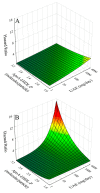Compositional Features of HDL Particles Interact with Albuminuria to Modulate Cardiovascular Disease Risk
- PMID: 30813431
- PMCID: PMC6412699
- DOI: 10.3390/ijms20040977
Compositional Features of HDL Particles Interact with Albuminuria to Modulate Cardiovascular Disease Risk
Abstract
Lipoproteins containing apolipoprotein B modify associations of elevated urinary albumin excretion (UAE) with cardiovascular disease (CVD). Additionally, it is known that elevated UAE alters high-density lipoprotein functionality. Accordingly, we examined whether HDL features might also modify UAE-associated CVD. Multivariable Cox proportional-hazards modeling was performed on participants of the PREVEND (Prevention of Renal and Vascular Endstage Disease) study at the baseline screening with standard lipid/lipoprotein analyses and, three-to-four years later (second screen), with nuclear magnetic resonance lipoprotein analyses focusing on HDL parameters including HDL particle (HDL-P) and apolipoprotein A-I concentrations. These were used with UAE and derived measures of HDL apoA-I content (apoA-I/HDL-C and apoA-I/HDL-P) in risk models adjusted for gender, age, apoB, diabetes, past CVD history, CRP and GFR. Interaction analysis was also performed. Baseline screening revealed significant associations inverse for HDL-C and apoA-I and direct for apoA-I/HDL-C. The second screening demonstrated associations inverse for HDL-P, large HDL-P, medium HDL-P, HDL size, and apoA-I/HDL-P. Significant interactions with UAE included apoA-I/HDL-C at the baseline screening, and apoA-I/HDL-P and medium HDL-P but not apoA-I/HDL-C at the second screening. We conclude that features of HDL particles including apoA-I/HDL-P, indicative of HDL apoA-I content, and medium HDL-P modify associations of elevated UAE with CVD risk.
Keywords: HDL; HDL subfractions; albuminuria; apolipoprotein A-I; urinary albumin excretion.
Conflict of interest statement
The authors declare no conflict of interest.
Figures



References
-
- De Jong P.E., Gansevoort R.T., Bakker S.J.L. Macroalbuminuria and microalbuminuria: Do both predict renal and cardiovascular events with similar strength. J. Nephrol. 2007;20:375–380. - PubMed
-
- Smink P.A., Heerspink H.J.L., Gansevoort R.T., de Jong P.E., Hillege H.L., Bakker S.J., de Zeeuw D. Albuminuria, estimated GFR. Traditional risk factors, and incident cardiovascular disease: The PREVEND (Prevention of Renal and Vascular Endstage Disease) Study. Am. J. Kidney Dis. 2012;60:804–811. doi: 10.1053/j.ajkd.2012.06.017. - DOI - PubMed
-
- Hillege H.L., Janssen W.M., Bak A.A., Diercks G.F., Grobbee D.E., Crijns H.J., Van Gilst W.H., De Zeeuw D., De Jong P.E., Prevend Study Group Microalbuminuria is common, also in a nondiabetic nonhypertensive population, and an independent indicator of cardiovascular risk factors and cardiovascular morbidity. J. Intern. Med. 2001;249:519–526. doi: 10.1046/j.1365-2796.2001.00833.x. - DOI - PubMed
MeSH terms
Substances
Grants and funding
LinkOut - more resources
Full Text Sources
Medical
Research Materials
Miscellaneous

